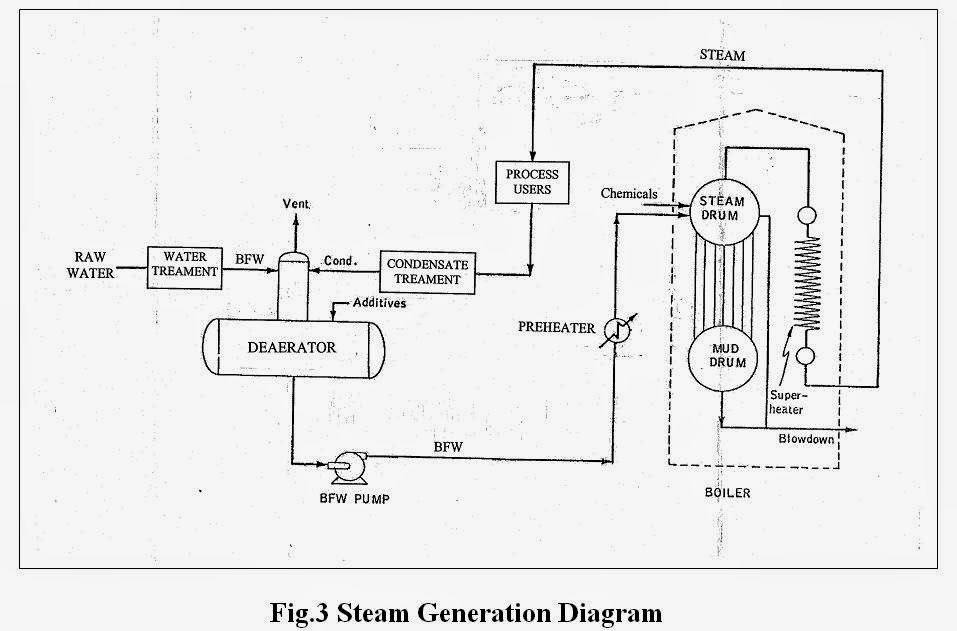Steam
System in petrochemical processing and Refinery
Steam system may be the most essential among
utility systems in chemical, petrochemical and refinery plants. It is widely
used in various applications. Because of its important magnitude, I decide to
introduce this system applied in plant with the purpose of helping process
apprentices to get the basic concept about steam application, supporting their
design works as well as operation.
Purpose and
Application
Thank to several advantageous properties,
steam is universally employed to support many processes occurring in
manufacturing. It plays an important part and is indispensable to keep the
plant operating smoothly. The purpose of steam is to provide heat and power.
Main applications maybe are as follows:
Steam for heat exchanger,
steam for stripping, cracking steam in refinery, heating steam for reboiler or
process vessel, steam for mechanical driver (e.g. turbine), steam tracing,
steam air decoking of heater, steam for smokeless flare…
It is used continuously or intermittently.
Steam
Distribution Level
To serve several service effectively, steam
is generally divided into three levels:
-
High pressure steam: ~2.0-4.1 Mpa, gauge
-
Medium pressure steam: ~ 1.1 Mpa, gauge
-
Low pressure steam: ~0.3 Mpa, gauge
Sometimes steam system may consist of more than above levels
depending on specific application.
One principle that needs to keep in mind is: using low
pressure steam in heating services wherever possible.
Superheated
steam
One term we must pay attention is superheated steam.
Superheated steam is steam heated to a temperature higher
than the boiling point corresponding to its pressure. It is needed to
distinguish with saturated steam, steam at the temperature of the boiling
point which corresponds to its pressure
point which corresponds to its pressure
Superheated steam has advantage of economical transportation
so that it is used to distribute throughout plant. Frequently steam is
superheated from 55 ℃to 195℃above saturation temperature
in steam coils located in the inlet portion of the boilers convective section.
When necessary it is desuperheated (reduce heat) to best
suite requirement as well as protect equipment from damage due to high
temperature. This process is carried out through an equipment called
Desuperheater.
Desuperheating is accomplished by atoming fluid
and cooling fluid. Cooling fluid is employed to reduce temperature of
superheated steam whereas atomizing fluid is needed when the pressure of the
system is not enough to make cooling fluid atomize.
Fig.2 Steam Network in a petrochemical plant
Steam Network System
To fully understand about how steam system work, please refer
to Fig. 2
In this network, steam system composes of three level: High,
medium and low pressure steam. High pressure steam coming from boiler is
desuperheated before going to high pressure-needed users. Desuperheating is
implemented by boiler feed water. Steam after used become to condensate (maybe
liquid or two phase). It is collected in flash drum. Flash drum has a duty to
separate entrained steam and condensate. One part of high pressure steam is
letdown to medium pressure steam by a control valve. Before coming to user, it
is also desuperheated prior to combining with steam from flash drum. Low
pressure steam is generated in the same way from medium pressure steam.
Condensate from the whole system goes from the last fresh drum to condensate
storage.
Steam
Generation System
Feed sources
Steam is generated in boiler from Condensate and Boiler Feed
Water.
Condensate
After steam come to users it loose heat and become
condensate. Condensate is recovered whenever economically justified and
returned to the deaerator as boiler feed makeup. Frequently the returned
condensate must be treated to remove dissolved and insoluble iron contaminants
before it is acceptable as feed.
Boiler Feed Water.
Boiler feed water is obtained from treating raw water. The
purpose of treating raw water is to remove impurities and metal cations that
may cause corrosion and fouling for the system.
System configuration
Please refer to Fig.3
for the system detail.
Boiler: Main
equipment of the system where steam is generated. Saturated steam leaving Steam
Drum is superheated in team Superheater. Chemicals are injected into Steam Drum
to concentrated the dissolved solid. To maintain the boiler water solids at an
acceptable concentration, a blowdown stream is continuously withdrawn from Mud
Drum and Steam Drum.
Deaerator: This
equipment is in charge of oxygen and carbon dioxide removal. If these entrained
gases present in water feed are not completely removed in the deaerator, the
resulting boiler feed water is aggressive and may cause severe corrosion of
boiler feedwater pump internals at areas of turbulence or high pressure drop.
Water feed is also preheated here to reduce boiler fuel consumption.
Pump: Responsible
for transfer water from Deaerator to Boiler. It also creates pressure high
enough for boiler requirement.
Preheater: To get
efficiency and save fuel for boiler, feed is further heated to partly turn
water feed into steam before being introduced into Steam Drum.
Finally, please refer to Fig 4 for overall view and detail
about steam system in plant. This sample Process Flow Diagram is taken from a
refinery.
Conclusion
It is difficult to mention all aspects of steam system in the
framework of this article. About specific information and system design guide I
will introduce in another time. However, with the concept knowledge presented
here I hope that it is useful to provide direction for new process engineer who
wish to get approach for system design in which steam is a system impossible to
be neglected.
Fig.4 Steam
System Diagram in Refinery



No comments:
Post a Comment